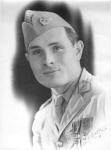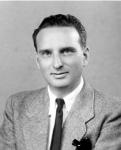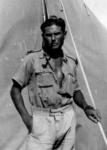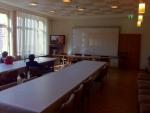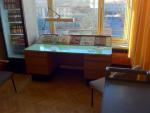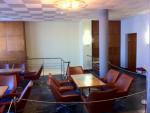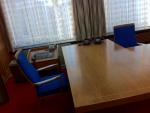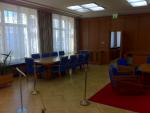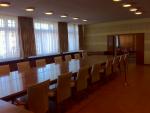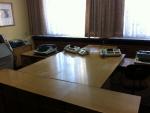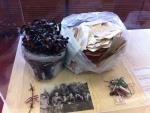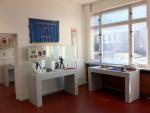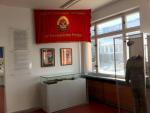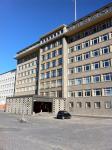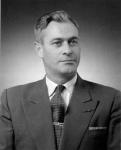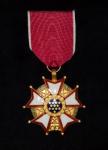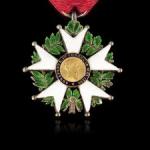-
Posts
3,939 -
Joined
-
Last visited
-
Days Won
1
Content Type
Profiles
Forums
Blogs
Gallery
Events
Store
Everything posted by Christophe
-

Only 75 Companions of the Liberation still alive!
Christophe replied to Christophe's topic in World War II 1939 to 1945
Only 29 surviving Companions of the Liberation. On 3 February 2012 died Bernard Demolins, Companion of the Liberation. Bernard Demolins, born in 1918, Bernard Demolins is incorporated in Casablanca, doing his military service. He is then appointed in Algeria, from where he joins Lebanon, and then London. On the July 1st, 1940, he meets the general de Gaulle in St Stephen' s House and gets involved in the Free French Force. He wil then participate in operations in Dakar and Gabon. He will then take part in operations against the Italian army in Eritrea, and then fights in Syria, where he is wounded. He will the take part in the battle of El-Alamein, in the Italy campaign in 1943, where he is again wounded in May 1944, in Garigliano. He will then fight as part of the France campaign. After the war, will start an Administrator career in Chad, New Caledonia, Mauritania and work for the United Nations. Here is his bio (in French) : http://www.ordredela...pagnon/275.html After his death, there are now only 29 surviving Companions of the Liberation. Ch. Pic : Chancellerie de l'Ordre de la Libération. -

Only 75 Companions of the Liberation still alive!
Christophe replied to Christophe's topic in World War II 1939 to 1945
Only 30 surviving Companions of the Liberation. Here is the list of these 30 Companions : Henri BEAUGE-BERURE Guy CHARMOT Daniel CORDIER Louis CORTOT Yves de DARUVAR Bernard DEMOLINS Victor DESMET Constant ENGELS Robert GALLEY René GATISSOU Alain GAYET Hubert GERMAIN Charles GONARD Jacques HEBERT Paul IBOS François JACOB Pierre LANGLOIS Claude LEPEU Louis MAGNAT Jean-Pierre MALLET Fred MOORE Roland de la POYPE Claude RAOUL-DUVAL André SALVAT Etienne SCHLUMBERGER Pierre SIMONET Gérard THEODORE Jean TRANAPE Edgard TUPET-THOME André VERRIER Ch. -

Only 75 Companions of the Liberation still alive!
Christophe replied to Christophe's topic in World War II 1939 to 1945
Only 30 surviving Companions of the Liberation. On 2 December 2011 died Henry Lafont, Companion of the Liberation. Henry Lafont, born in 1920, was at the fighter school in Oran, Algeria. With some of his fellow pilots, led by René Mouchotte, they decided to steal an aircraft and fly to Gibraltar. A few days later they sailed for England, from where he flew patrols during the Battle of Britain. Over the next few months he flew more than 100 patrols and was credited with shooting down two enemy aircraft. On February 26 1941 he was the first of the pilots who had escaped to England to achieve a success, although he was the only one in his formation of six aircraft to return safely to base. In July 1941 Lafont became an instructor, and trained more than 60 Free French Air Force fighter pilots. Six months later he joined the Groupe Alsace flying Hurricanes on convoy patrols and fighter cover over Tobruk, when he probably shot down an enemy bomber. In May 1942 he volunteered for service in Russia with the Normandie Squadron, but before joining he was shot down and wounded. He returned to England. Throughout 1943 Lafont flew on operations over France and the Low Countries. By war’s end he had completed 230 operational missions. After the war, Henry Lafont remained in the French Air Force, serving in Algeria during the conflict there and for six years in London. He was later, in 1967, appointed Director General of the Paris Air Show. Here is his bio (in French) : http://www.ordredela...pagnon/538.html After his death, there are now only 30 surviving Companions of the Liberation. Ch. Pic : Chancellerie de l'Ordre de la Libération. -

Only 75 Companions of the Liberation still alive!
Christophe replied to Christophe's topic in World War II 1939 to 1945
Only 31 surviving Companions of the Liberation. On 18 November 2011 died Robert Bineau, Companion of the Liberation. Robert Bineau, born in 1914, made the campaign in Belgium. He injured his right eye on 1st June 1940, during the evacuation of Dunkirk. On 1st July, he decided to join the Free French Forces. It serves primarily to the coastal battery at Pointe-Noire and participates in the defense of Fort Lamy under the command of Colonel Leclerc. In May 1942, he moved to Bir Hakeim 1st Artillery Regiment of the 1st Free French division. After the battles of El Alamein, he took part with the first colonial artillery regiment in the battles of Libya and Tunisia. During the Italian campaign of 1944, he distinguished himself on several occasions, and again has been injured in the leg. He participated in landings in Provence, to fight the Belfort Gap then in Strasbourg in January 1945 and April 1945 in the Alps where he replaced his unit commander wounded. After the war, he resumed his civil functions as a Treasurer. Here is bio (in French) : http://www.ordredelaliberation.fr/fr_compagnon/101.html After his death, there are now only 31 surviving Companions of the Liberation. Ch. Pic : Chancellerie de l'Ordre de la Libération. -

Only 75 Companions of the Liberation still alive!
Christophe replied to Christophe's topic in World War II 1939 to 1945
Only 32 surviving Companions of the Liberation. On 30 October 2011 died René Bauden, Companion of the Liberation. René Bauden, born in 1918, is doing his military service in the Air Force when the War starts. Assigned to the Levant, in December 1939, he became a sergeant mechanic before joining Damascus. Not accepting the armistice, he wanted to continue fighting and joined the British lines in Transjordan. A few days later, it is incoporé in the RAF at Heliopolis before being assigned to the Number one french bomber flight, a small French unit part of the 8th Squadron. Having trained as a radio-gunner, he takes part in several missions during the campaign in Eritrea. In May 1941, it is integrated with the Free French Air Forces (FAFL) and joined the Group booked bombing # 1. A few months later, this unit will become the Lorraine Bomber Group and No. 342 Squadron when it is integrated with the RAF. In December of that year, when he is on a mission aboard a Blenheim bomber over Libya, he shot one of Messerschmitt 109 that attacked her plane. Back in Britain, he was promoted to sergeant. With Lorraine Bomber Group, it performs some forty missions over occupied France and Germany. In February 1945 he left the Lorraine to join the transport group 1/15, equipped with Dakota (the militarized version of the DC-3). He finished the war with the rank of second lieutenant. After the war, René Bauden returned to his job at the post office that he held until his retirement. Here is his bio (in French) : http://www.ordredela...mpagnon/60.html After his death, there are now only 32 surviving Companions of the Liberation. Ch. Pic : Chancellerie de l'Ordre de la Libération. -

Only 75 Companions of the Liberation still alive!
Christophe replied to Christophe's topic in World War II 1939 to 1945
Only 33 surviving Companions of the Liberation. On 26 October 2011 died Pierre Deshayes, Companion of the Liberation. Pierre Deshayes, born in 1918, is mobilized in 1939. He was taken prisoner in June 1940 before being released in September because of his qualifications necessary for the proper functioning of the railway network. In January 1941, determined to resist, he left France for Spain and Portugal, Gibraltar in order to join the Free French Forces. His journey to get to Britain was complicated when the cruiser which was to take him there had been diverted from its course to join the hunt for Bismarck.He finally joined Scotland in mid-July 1941. He made sevral dangerous missions from the winter of 1942, in the metropolis, and held major responsibilities in the Central Bureau of Intelligence and Action (BCRA), and the Air Operations Office (BOA). Its activities focused more specifically on the five departments of northern France. It has established a network of leaders departmental committees. He will continue his Resistance missions until the French Liberation. After the war, Pierre Deshayes worked at la newspaper La Voix du Nord. Here is his bio (in French) : http://www.ordredelaliberation.fr/fr_compagnon/279.html After his death, there are now only 33 surviving Companions of the Liberation. Ch. Pic : Chancellerie de l'Ordre de la Libération. -

DDR In the Stasi...
Christophe replied to Christophe's topic in Germany: Post 1945: Bundesrepublik & DDR
-

DDR In the Stasi...
Christophe replied to Christophe's topic in Germany: Post 1945: Bundesrepublik & DDR
And the new "cafeterias"... As you can see, still work in progress... Ch. Pic : © Christophe – ChR Collection -

DDR In the Stasi...
Christophe replied to Christophe's topic in Germany: Post 1945: Bundesrepublik & DDR
In the previous version of the museum, the relaxing room of the Stasi officers, close to the big meeting room, had been transformed in a small cafeteria open to visitors. Again, please, see my pics in my first posts... Now, this is finished. I have again asked why the change, and have been told that it damaged the furniture... Probably exact. So, the have opened new cafeteria spaces, but located in very curious places, not planned for this use, as you can see below... The first pic is the former officers' relaxing room. Ch. Pic : © Christophe – ChR Collection -

DDR In the Stasi...
Christophe replied to Christophe's topic in Germany: Post 1945: Bundesrepublik & DDR
-

DDR In the Stasi...
Christophe replied to Christophe's topic in Germany: Post 1945: Bundesrepublik & DDR
-

DDR In the Stasi...
Christophe replied to Christophe's topic in Germany: Post 1945: Bundesrepublik & DDR
-

DDR In the Stasi...
Christophe replied to Christophe's topic in Germany: Post 1945: Bundesrepublik & DDR
-

DDR In the Stasi...
Christophe replied to Christophe's topic in Germany: Post 1945: Bundesrepublik & DDR
Erich Mielke's office and other work rooms : Nothing really changed except some phones that have been mixed, compared to the previous exhibition... Nothing really significant. Except one thing : the death mask of Lenin that was on Mielke's desk is not here anymore. I asked why. I have been told it was under restoration. It should come back... Inshallah !!! Another change : now you can find panels with bilingual captions (German + English). Understanding German, I personaly preferred the "old" way of information : a small booklet with the complete translations of the captions and panels that were in German only... Today, unfortunately, not a lot of information available... Ch. Pic : © Christophe – ChR Collection -

DDR In the Stasi...
Christophe replied to Christophe's topic in Germany: Post 1945: Bundesrepublik & DDR
-

DDR In the Stasi...
Christophe replied to Christophe's topic in Germany: Post 1945: Bundesrepublik & DDR
-

DDR In the Stasi...
Christophe replied to Christophe's topic in Germany: Post 1945: Bundesrepublik & DDR
Exhibition rooms : less to be seen, obviously... Very "clean" and "lean" exhibitions... More focused on objects than explanation and text... Quite different that it wasd in the past with a lot of panels (german style of exhibition). But, when I went there, there seems that some rooms were not finished... Half a floor - of the 3 floors of the building where access is permitted - was closed to visitors. Work still on progress... I believe this is the first time they show in "Haus 1" the destroyed and teared paper files of the Stasi... See below... Ch. Pic : © Christophe – ChR Collection -

DDR In the Stasi...
Christophe replied to Christophe's topic in Germany: Post 1945: Bundesrepublik & DDR
To be noticed : the Control Post (you could see it in my Pic #3 in my first post) is no more visible. During the refurbishment, it was exhibited in "Haus 22", the place of the temporary exhibition. Maybe it is now being restorated ? I hope it will come back... The Entrance Hall has been very well re-done, perfectly in the spirit of the past... The Prisoner Transport vehicle (GTW) is still there. Ch. Pic : © Christophe – ChR Collection -

DDR In the Stasi...
Christophe replied to Christophe's topic in Germany: Post 1945: Bundesrepublik & DDR
The building as it is nowadays. Not a lot of changes. It is not visible on the pic, but on the pavement, they have drawn lines for parking, including coaches parking... Ch. Pic : © Christophe – ChR Collection -

DDR In the Stasi...
Christophe replied to Christophe's topic in Germany: Post 1945: Bundesrepublik & DDR
These last years, this Stasi museum and its hosting building went under refurbishment. Meanwhile and until mid-January 2012, The "museum" part has been located in a small buiding facing this one "Haus 22", that used to be a building with meeting rooms and cafeteria... The Museum has re-opened in "Haus 1". Museum website : Stasimuseum Berlin - Forschungs- und Gedenkst�tte Normannenstra�e There are some slight changes even if most of the spirit has been kept... Here are a few comments and pics on what has (or not) changed in the Stasi museum... Globally speaking, not a lot of changes... But, I'm sure that what is shown today might not be the definitive version of the exhibition. Why ? First there is still some work around the building. Not all is finalized... Second there are, in "Haus 1", less rooms open to the visitors. And inside these, there seems to be less items displayed... And, for example, you don't have access anymore to the jail cell... Third, in terms of facilities, they have created some new spaces for visitors, like, for example, several cafeteria... but in places where I doubt they will remain, at least according to the present formula... Let's pics speak... Ch. -
Hi Christian, You're back!!! Fantastic!! We missed you a lot these last years. So, welcome back!! Unfortunately, not a lot of time, at present to elaborate and answer your suggestions... but will come back to your points a soon as possible Cheers. Ch.
-

Only 75 Companions of the Liberation still alive!
Christophe replied to Christophe's topic in World War II 1939 to 1945
Only 34 surviving Companions of the Liberation. On 22 October 2011 died Henri de Bordas, Companion of the Liberation. Henri de Bordas, born in 1921, refusing defeat, sailed for England, two days after the signing of the armistice, and joined the Free French Air Forces. He was posted to a flight school of the Royal Air Force (RAF). Patented fighter pilot, he joined successively Squadrons 242, 131 and 91 of the RAF, before being poured in 340 Squadron "Ile de France". Subsequently, he was assigned to Squadron Free French, ie the "Alsace", in which will illustrate Clostermann Pierre, Rene Mouchotte or Christian Martell. Finally, promoted to captain in September 1944, he finished the war with 329 Squadron. He participated in flight operations related to the case of Dieppe (1942), the Allied landings in Normandy (June 1944) and the campaigns of Holland and Germany. It will total 480 hours of flight of war for 140 offensive missions and 180 other defensive, with 11 air victories to his credit, including 10 German V-1 missiles. After the war, Henri de Bordas held various positions within the Air Force and became Air Attache at the Embassy of France at Washington. He joined then the personal staff of General de Gaulle at the Elysee Palace. He then commanded the Air IV region. During the 1970s, as a general, he became advisor to the government for defense matters and technical inspector of the Air Force. From 1977 to 1983, he chaired the Foundation for National Defence Studies. Here is his bio (in French) : http://www.ordredelaliberation.fr/fr_compagnon/124.html After his death, there are now only 34 surviving Companions of the Liberation. Ch. Pic : Chancellerie de l'Ordre de la Libération. -

Only 75 Companions of the Liberation still alive!
Christophe replied to Christophe's topic in World War II 1939 to 1945
Only 35 surviving Companions of the Liberation. On 4 May 2011 died Rudolf Eggs, Companion of the Liberation. Rudolf Eggs, born in 1915, of Swiss origin, has fought in Norway in 1940. Embedded in Narvik to Brest in June 1940, he was then evacuated to England. In July, he joined the Free French Forces under the name Robert Goldbin. He will then took part in the battle of dakar, and fight in Cameroon, Gabon, Eritrea, Syria, Tunisia. He joined the Italian front in April 1944, before participating in the landing in Provence in August 1944. He was wounded on September at Autun, and then during the Battle of Colmar, in January 1945. After the war, Rudolf Eggs, returned to North Africa with his unit in August. Successively assigned to Indochina (1946-1954), Morocco (1954-1957), Algeria (1957-1959 and 1960-1962), Strasbourg (April 1959-June 1960) and Madagascar (1962-1964), he retired as a commander. He obtained French nationality in 2007. Here is his bio (in French) : http://www.ordredelaliberation.fr/fr_compagnon/409.html After his death, there are now only 35 surviving Companions of the Liberation. Ch. Pic : Chancellerie de l'Ordre de la Libération. -
-
Hi Nick, Any news or update about the membership levels ? Cheers. Ch.


